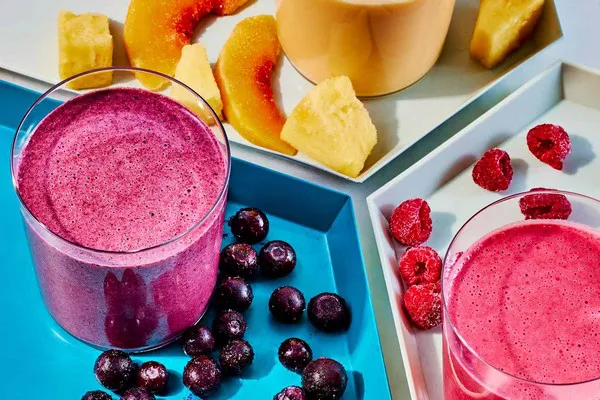Breakfast is often hailed as the most important meal of the day, setting the tone for your energy levels, mood, and overall health throughout the day. With the hustle and bustle of modern life, many people are turning to convenient options like smoothies to start their mornings. But is drinking a smoothie for breakfast truly healthy? Let’s delve into this question by exploring various aspects of smoothies, including their nutritional value, potential benefits, drawbacks, and tips for making healthier choices.
Nutritional Value of Smoothies
Smoothies are generally made by blending fruits, vegetables, a liquid base (such as milk, yogurt, or a plant-based milk alternative), and sometimes additional ingredients like protein powder, seeds, nuts, or honey. The nutritional value of a smoothie largely depends on the ingredients used.
Fruits and Vegetables
Fruits and vegetables are rich in essential vitamins, minerals, antioxidants, and dietary fiber. By incorporating a variety of these into your smoothie, you can boost your intake of nutrients like vitamin C, potassium, and fiber. For example, berries are high in antioxidants and fiber, while leafy greens like kale and spinach provide iron, calcium, and vitamins A and K.
Liquid Base
The choice of liquid base can significantly affect the nutritional profile of your smoothie. Dairy milk offers protein and calcium, while plant-based milks like almond, soy, or oat milk provide different nutrients and can be suitable for those with dairy allergies or intolerances. Be mindful of the sugar content in some plant-based milks, however, as they may be high in added sugars.
Protein Sources
Adding protein to your smoothie can help keep you full longer and support muscle recovery and growth. Protein sources can include dairy yogurt, plant-based yogurt alternatives, protein powder, seeds (like chia or hemp), or nuts. Greek yogurt, for instance, is high in protein and probiotics, which are beneficial for gut health.
Healthy Fats
Including healthy fats in your smoothie can enhance its nutritional value and satisfaction. Avocado, nuts, seeds, and nut butters are excellent sources of monounsaturated and polyunsaturated fats, which are crucial for heart health and overall well-being.
Sweeteners and Flavorings
While natural sweeteners like honey or maple syrup can add a touch of sweetness, they should be used sparingly to avoid excess calorie intake. Artificial sweeteners are another option but should be used cautiously as their long-term health effects are still being studied.
Potential Benefits of Smoothies for Breakfast
Convenience
One of the most significant benefits of smoothies is their convenience. You can prepare them quickly, take them on the go, and enjoy a nutritious meal without much hassle. This is especially useful for busy individuals who might otherwise skip breakfast or opt for less healthy options.
Nutrient Density
Smoothies allow you to pack a lot of nutrients into one drink. By incorporating a variety of fruits and vegetables, you can ensure a broad spectrum of vitamins, minerals, and antioxidants in your morning meal. This nutrient density can be particularly beneficial for those looking to improve their overall diet or meet specific health goals.
Hydration
Starting your day with a smoothie can help you stay hydrated. The liquid base ensures that you’re consuming fluids early in the morning, which is important for overall health and cognitive function.
Digestion
Smoothies can be easier to digest than some other breakfast options, like whole grains or dense proteins. This can be beneficial for those with digestive issues or who prefer a lighter start to their day.
Customizability
Smoothies offer endless possibilities for customization. You can tailor your smoothie to your taste preferences, dietary restrictions, and health goals. Whether you’re looking to boost protein intake, increase fiber, or add more greens to your diet, smoothies provide a flexible platform for experimentation.
Potential Drawbacks of Smoothies for Breakfast
Calorie Intake
One potential drawback of smoothies is their calorie content. Depending on the ingredients, smoothies can be high in calories, especially if they contain added sugars, high-fat dairy products, or large portions of fruit. Excessive calorie intake can lead to weight gain over time.
Fiber Content
While smoothies can be high in vitamins and minerals, blending fruits and vegetables can reduce their fiber content. Fiber is essential for digestion, blood sugar control, and overall health. To mitigate this, try to include some whole fruit pieces or seeds in your smoothie to increase fiber intake.
Satiety
Some people may find that smoothies don’t keep them full for as long as other breakfast options. This can lead to overeating later in the day or snacking on unhealthy foods. Adding protein and healthy fats to your smoothie can help improve satiety, but it’s still something to be mindful of.
Sugar Content
The natural sugars in fruits can add up quickly in smoothies, especially if you use multiple types of fruit or large portions. High sugar intake has been linked to various health issues, including obesity, diabetes, and heart disease. To keep sugar levels in check, aim for a balance of fruits and vegetables, use low-sugar liquid bases, and avoid adding extra sweeteners.
Portion Size
It’s easy to overdo it with smoothies, especially if you’re using a large blender. Be mindful of portion sizes and try to stick to a single-serving smoothie to avoid consuming too many calories or nutrients.
Tips for Making Healthier Smoothies
Balance Your Ingredients: Aim for a balanced smoothie by incorporating a variety of fruits, vegetables, a protein source, and some healthy fats. This will ensure a broad spectrum of nutrients and help keep you full longer.
Use Low-Sugar Options: Opt for low-sugar fruits like berries and opt for unsweetened plant-based milks or water as your liquid base. If you need extra sweetness, use a small amount of natural sweetener like honey or maple syrup.
Add Fiber: Incorporate fiber-rich ingredients like whole fruit pieces, seeds, or nuts to increase the fiber content of your smoothie. This will help with digestion and keep you feeling full.
Watch Portion Sizes: Be mindful of portion sizes to avoid consuming too many calories. Stick to a single-serving smoothie and enjoy it as part of a balanced diet.
Experiment with Ingredients: Don’t be afraid to experiment with different ingredients to find what works best for you. Try incorporating new fruits, vegetables, and protein sources to keep your smoothies interesting and nutritious.
Prepare in Advance: Smoothies can be a great way to meal prep. Make a batch of smoothie ingredients in advance and store them in the freezer. This way, you can quickly blend a smoothie whenever you need one, without having to chop and measure ingredients each morning.
Conclusion
In conclusion, drinking a smoothie for breakfast can be a healthy and convenient option, but it’s important to be mindful of the ingredients and portion sizes. By incorporating a variety of fruits, vegetables, protein sources, and healthy fats, you can create a nutrient-dense smoothie that supports your health goals. However, it’s essential to watch out for high calorie and sugar content, and ensure that smoothies are part of a balanced diet. Experiment with different ingredients, watch your portion sizes, and enjoy the convenience and nutritional benefits of smoothies as part of your healthy lifestyle. Remember, the key to a healthy breakfast is finding what works best for you and your unique needs.
Related Topics:



























